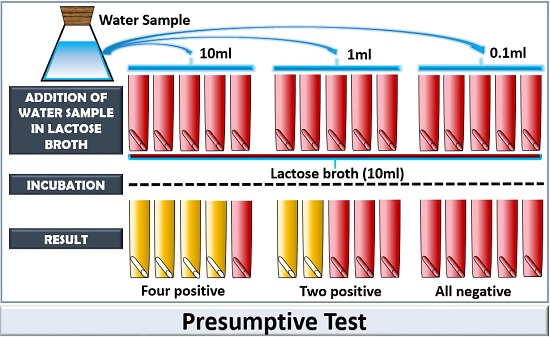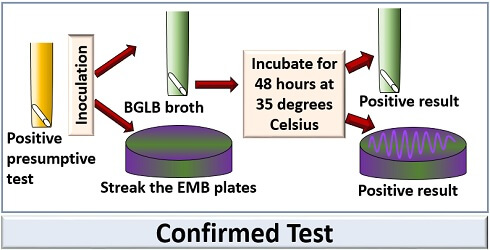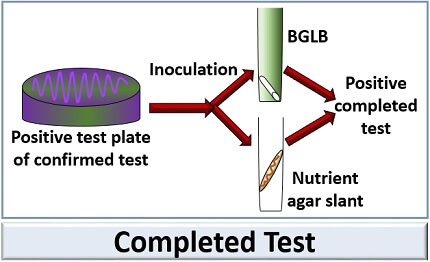A most probable number method is practised for the qualitative and quantitative water to determine microorganisms’ presence (mainly coliforms). “MPN” is an acronym for most probable number. Multiple tube fermentation test or MPN method determines the quality of water by quantifying the number of coliforms in 100 ml of the water sample.
MPN test involves a series of a test tube containing fermentative broth, in which the water samples are added in a definite proportion. We can detect coliform in the water sample by observing the fermentation tube for the production of acid and gas. A colour change in the fermentative broth (from red to yellow) indicates the production of acid.
Formation of gas bubbles in an inverted Durham tube indicates the production of gas in the fermentation tube. A most probable number is extensively used to estimate or determine the number of microorganisms from the large samples like water, soil etc. MPN test detects the presence or absence of faecal coliforms, which can cause faecal contamination in water and making it unsafe for human consumption.
Therefore, the quality testing of water becomes necessary to know the concentration of microorganisms or water quality, i.e. whether water is potable or not. In this lesson, we will discuss the definition. principle, methods, advantages and disadvantages of the most probable number test.
Content: Most Probable Number Method
Definition of MPN
MPN stands for a most probable number. It refers to the qualitative and quantitative analysis of water, which can enumerate the presence of faecal coliforms. E.coli is a common faecal contaminant present in water, and it can cause serious illness if it goes into the body. Thus, in most probable number method, E.coli is used as “Pollution indicator” to analyse the water quality. The most probable number includes three sets of methods like presumptive, confirmative and completed-test.
Principle of Most Probable Number
A most probable number is a statistical method, in which the results are compared with the standard statistical tables. It involves three sets of dilutions containing fermentative broth and the water sample. The formation of acid and gas indicates a positive result. The quantitative analysis of coliform is determined by counting the number of tubes giving a positive result and comparing the pattern of positive results with the statistical data.
Method of Most Probable Number
MPN is a method, which involves three consecutive tests, namely presumptive, confirmatory and completed-test.
Presumptive Test
The preliminary or screening test uses a series of fermentation tube containing lactose broth of known concentration. The negative presumptive analysis indicates that the water is microbiologically safe and does not require further testing. But in the case of positive results, one needs to confirm the presence of coliforms through the confirmed MPN-test.
The production of gas requires 40-390 million per ml of coliforms according to the Chambers. The gas formation depends upon the ratio of coliform to the non-coliforms. If the ratio of non-coliform bacteria is high, it will also reduce the production of gas. The presumptive test involves the following steps:

Procedure of Presumptive Test
- In a sterile conical flask add 40 g of the MacConkey broth in 1000 ml of distilled water to prepare a single strength medium. In the other flask, add 80 g of the MacConkey broth in 1000 ml of distilled water to prepare a double strength medium. The composition of MacConkey broth requires:
- Peptic digest of animal tissue: 20.0 g
- Lactose: 10.0 g
- Bile salts: 5.0 g
- NaCl: 5.0 g
- Neutral red: 0.75 g
- Distilled water: 1 L
- Then, sterilize the flasks in an autoclave for 15 minutes at 121 degrees Celsius.
- After autoclaving, take water samples in a series of test tubes. Add the known concentration of water into the three sets like 10 ml in first five tubes, 1ml in the other five tubes and 0.1 ml in the last five tubes. To test 10 ml of a water sample, add 10 ml of double strength MacConkey medium. Conversely, to check 1 ml and 0.1 ml of a water sample, add 10 ml of single strength MacConkey medium.
- Incubate the tubes for 24-48 hours at 35 degrees Celsius.
Observation: After incubation, the results are made based on any colour change or gas production in the MacConkey broth.
Result interpretation: The colour change of MacConkey broth from red to yellow and the gas production inside the Durham tube will indicate a positive result for the presumptive test. If the broth colour remains the same, i.e. red and no gas forms, it will give a negative result for the presumptive test.
Confirmed Test
It is the confirmatory test ensuring the presence of coliform by testing the positive tubes of the presumptive test. The gas produced in the presumptive test does not mean that there must be coliform in the water sample. Many other microorganisms are also present in water, which can give a false presumptive test.
Some yeasts and Clostridium species are present in the water, which can ferment lactose by producing both acid and gas. Therefore, it becomes necessary to confirm the presence of coliform in water. A confirmed test can be performed usually in two ways:
- In brilliant green lactose bile broth (BGLB)
- In eosin methylene blue agar medium (EMB)

Testing of positive presumptive in BGLB medium
Procedure
- First, prepare a solution of brilliant green lactose bile broth medium by taking the following components:
- Peptone: 10 g
- Lactose: 10 g
- Bile salt: 20 g
- Brilliant green: 0.0133 g
- Distilled water: 1 L
- Sterilize the BGLB medium in an autoclave for 15 minutes at 121 degrees Celsius.
- Shake the positive presumptive tubes gently.
- Then transfer a loopful of culture into the BGLB fermentation tube. The brilliant green dye in the BGLB medium inhibits the growth of gram-positive bacteria.
- Incubate the test tubes for 48 hours at 35 degrees Celsius.
Observation: Observe the test tubes containing BGLB medium and inoculum of positive presumptive test for the production of gas in the inverted Durham tube.
Result interpretation: The production of gas in the BGLB medium indicates the presence of coliforms
Testing of positive presumptive in EMB medium
Procedure
- First, prepare a solution of eosin methylene blue agar medium by taking the following components:
- Peptone: 10 g
- Agar: 15 g
- Lactose: 10 g
- Eosin Y: 0.4 g
- Methylene blue: 0.065 g
- Dipotassium hydrogen phosphate: 2 g
- Distilled water: 1L
- Sterilize the EMB agar in an autoclave for 15 minutes at 121 degrees Celsius.
- Pour the EMB medium onto the sterilized Petri plates and allow it to solidify.
- Shake the positive presumptive tubes gently.
- Then streak a loopful of culture onto the EMB agar media.
- Incubate the test tubes for 48 hours at 35 degrees Celsius.
Observation: Observe the plates for the appearance of bacterial colonies on the EMB media. Generally, three types of colony develops:
- Typical colony: It confirms by the appearance of a nucleated colony and may form a metallic sheen.
- Atypical colonies: It produces non-nucleated, opaque and mucoid colonies.
- Negative colonies: It produces other types of colonies.
Result interpretation: The production of a typical colony indicates the presence of coliform bacteria.
Completed Test
It is the final test to ascertain the presence of coliforms. A completed test involves the following steps:

Procedure of Completed Test
- Take a loopful of culture from positive confirmed tube.
- Inoculate a culture either in BGLB medium or by streaking the culture onto the agar slants.
- Incubate the test tubes for 24-48 hours at 35 degrees Celsius.
Observation: Observe the test tubes for gas production in BGLB medium or the growth of a bacterial colony in the agar slants.
Result interpretation: The production of gas in the Durham tube of the BGLB fermentation tube confirms the presence of coliform bacteria. The growth of gram-negative, non-sporing rods in the agar slants confirms the presence of coliforms.
Advantages
- Through the MPN method, turbid water containing sediments, sludge, mud etc. can be analysed.
- The result’s interpretation is easy by observing the production of gas or by the growth of gram-negative rod-shaped coliforms.
- Most Probable Number test is applicable for all the types of water, which is an advantage over the membrane filtration method.
Disadvantages
- To confirm coliforms’ presence, it includes three tests that take a long time to get the results.
- MPN is a very sensitive method, which sometimes can give false results.
- Most probable number method requires multiple test tubes and many glasswares for the media preparation.
In the MPN method, a number of tubes showing positive results will estimate the coliform count per 100ml. The numbers are compared with the statistical data that Maccardy gave.
It’s an excellent description of MPN testing for water analysis. Very nicely described, and the procedure is made easy so that a person without any knowledge in microbiology can understand the testing protocol.